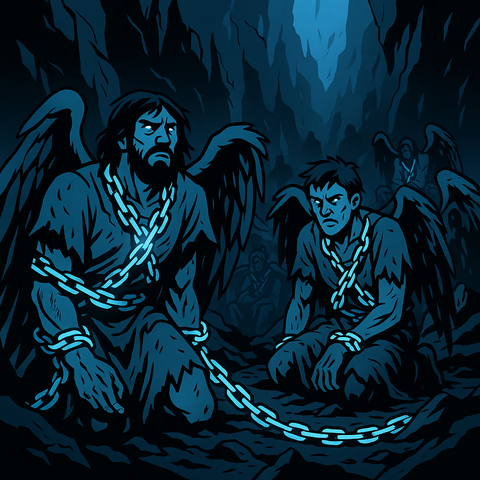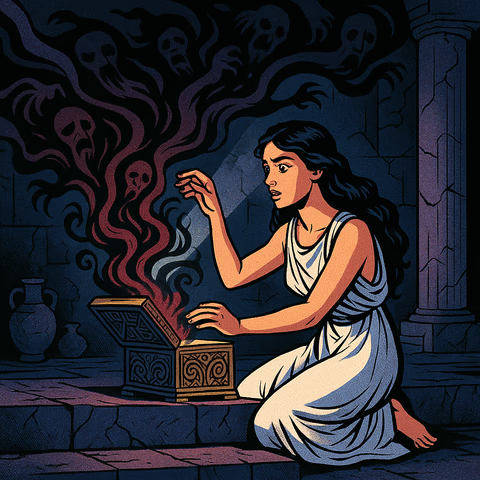
What is Tartarus?
The Apostle Peter mentions Tartarus. Why is this pagan Greek religious concept mentioned in a New Testament letter?
2 Peter 2:4 says:
‘If The God didn’t spare the [spirit] messengers who sinned, but [instead, He] confined them in darkness, [and] having thrown them into ‘Tartarus’, He delivered them to punishment [and] to be held for judgment.’
This actually concludes a chain of information found throughout the Bible:
- Genesis 6:1-4 speaks of ‘sons of The God’ coming to earth and taking ‘the daughters of mankind’.
- 1 Peter 3:19, mentions ‘spirits’ (literally, breaths) that were put into ‘prison’ for the bad acts they committed during the time of Noah.
- Then, in the Greek version of 2 Peter 2:4, we read that they were cast ‘into Tartarus’.
What is Tartarus? Is it Hell?
Some Bibles deliberately mistranslate ‘Tartarus’ as ‘Hell’ or ‘Hell Fire’ in order to deceive their readers. Not only does the word not mean that, but Hell Fire is a concept centuries away in Christian belief. In this early period when 2 Peter was written, Christians believed in a future bodily resurrection of both righteous and wicked humans:
‘…the time is coming when everybody in the tombs will hear his voice and come out… Those who did good things to a resurrection of life, and those who practiced what’s foul to a resurrection of judgment’ (John 5:28-29)
‘…there’s going to be a resurrection of the righteous and the unrighteous’. (Acts 24:15)
And this was to occur in the future:
‘[some Christians] got away from the truth and started teaching that the resurrection has already happened, which misdirected the faith of some’. (2 Timothy 2:18)
So Tartarus is not ‘Hell Fire’, but actually something entirely different and much more specific.
A Deep Abyss
Tartarus is a pagan Greek term that refers to a cold, dark, deep abyss.
At first, it was a dungeon where the former Greek gods, the Titans, were imprisoned and punished after being overthrown by their children. In later times, Greek thought progressed, and myths arose where the ‘souls’ of some humans who sinned against the gods in an extraordinary way were also sent to Tartarus as punishment (e.g. King Salmoneus, after he pretended to be Zeus).
Tartarus was understood as a separate place from ‘Hades’, the Greek underworld where the dead went in general. Tartarus was, in fact, meant to be even deeper into the earth than Hades. The Greek epic poem, the Iliad, says that Tartarus is:
‘as far beneath Hades as heaven is above earth’.
So, generally, Tartarus was where the Greeks believed deposed gods were imprisoned and punished, and some human ‘souls’ also went there if they had particularly offended the gods.
This naturally raises the question of why did Peter use a pagan term from Greek Mythology to describe the condition of unfaithful messengers (angels) of the true God?
Greek Mythology is a distorted version of the Bible

Greek Mythology seems to tell highly distorted versions of real ancient events that are more accurately recorded in the Bible. These events are from Genesis chapters 2 through 6.
Stories such as Hercules and the Golden Apples, Pandora’s Box, Medusa, immoral Gods that came to earth, and so on, are distorted versions of:
- Adam and the forbidden fruit
- Eve who brought evil upon all mankind
- The snake in the Paradise
- The sons of God that came to earth and lived as humans
Therefore, it could be that they also had a name for the place where these sons of God (the ‘gods’) were sent after the Great Downpour: Tartarus. Since this correct idea was common at the time, Peter may have used the word to convey what he was talking about to his readers.
Tartarus as an illustration
It’s possible that Peter’s mention of Tartarus is an added illustration to help his readers understand what he was talking about by using images familiar to them.
For that reason, we put ‘scare quotes’ around the word ‘Tartarus’, as it looks to us like a figurative expression, not an actual confirmation of the existence of the Greek concept of Tartarus.
So what happened to these fallen angels?
It could mean that the fallen angels who mated with women before the flood really are confined to some kind of spirital prison. If they were not, then Peter shouldn’t have mentioned Tartarus, nor should he have mentioned ‘prison’ in 1 Peter 3:19.
This implies that the demons described in Jesus’ day are not the same as the angels who mated with women before the flood, because they are in prison. A popular belief in the 1st century was that the demons are the disembodied spirits of the Nephelim, the half-human, half-angelic offspring of the fallen angels.
Popular texts, such as 1 Enoch, claimed that the Nephelim were partly spirit creatures due to being half-human, half-angelic. And upon losing their human bodies, these are now floating around the earth, acting as demons.
However, this interpretation is not described anywhere in the Bible books that people generally consider to be inspired.
Absent from the Aramaic translation
Interestingly, the Aramaic translation of 2 Peter (which was very early), does not say ‘Tartarus’. It just says that the fallen angels were put in chains and cast down into deep darkness:
‘[God] cast them down to the infernal regions in chains of darkness’. (Murdock)
Bible Questions
 Is it Proper for a Christian to Swear an Oath?
Is it Proper for a Christian to Swear an Oath? Should We End Prayers with 'In Jesus' Name' and 'Amen'?
Should We End Prayers with 'In Jesus' Name' and 'Amen'? What is Tartarus?
What is Tartarus? Why does the King James Version mention unicorns?
Why does the King James Version mention unicorns?
Also see our Articles index and our About section.